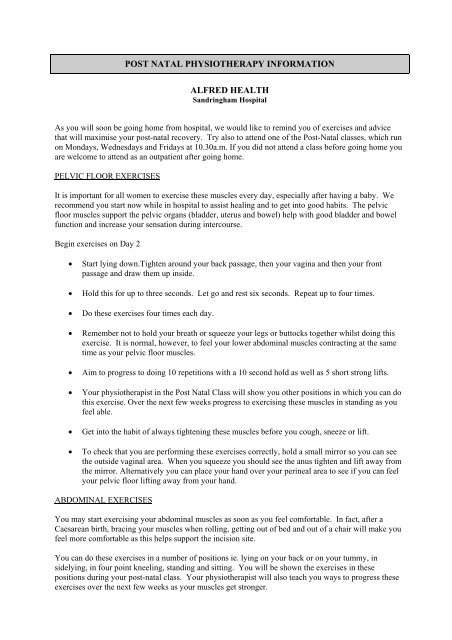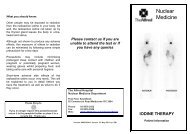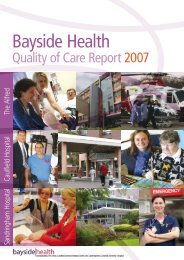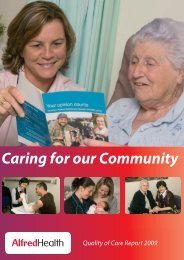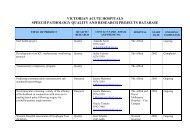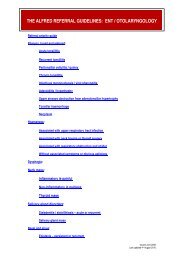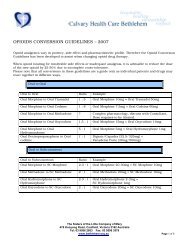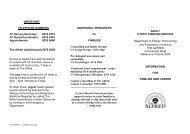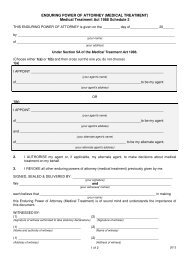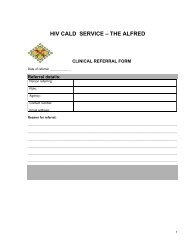Postnatal physiotherapy exercises for patients - Alfred Hospital
Postnatal physiotherapy exercises for patients - Alfred Hospital
Postnatal physiotherapy exercises for patients - Alfred Hospital
Create successful ePaper yourself
Turn your PDF publications into a flip-book with our unique Google optimized e-Paper software.
POST NATAL PHYSIOTHERAPY INFORMATION<br />
ALFRED HEALTH<br />
Sandringham <strong>Hospital</strong><br />
As you will soon be going home from hospital, we would like to remind you of <strong>exercises</strong> and advice<br />
that will maximise your post-natal recovery. Try also to attend one of the Post-Natal classes, which run<br />
on Mondays, Wednesdays and Fridays at 10.30a.m. If you did not attend a class be<strong>for</strong>e going home you<br />
are welcome to attend as an outpatient after going home.<br />
PELVIC FLOOR EXERCISES<br />
It is important <strong>for</strong> all women to exercise these muscles every day, especially after having a baby. We<br />
recommend you start now while in hospital to assist healing and to get into good habits. The pelvic<br />
floor muscles support the pelvic organs (bladder, uterus and bowel) help with good bladder and bowel<br />
function and increase your sensation during intercourse.<br />
Begin <strong>exercises</strong> on Day 2<br />
• Start lying down.Tighten around your back passage, then your vagina and then your front<br />
passage and draw them up inside.<br />
• Hold this <strong>for</strong> up to three seconds. Let go and rest six seconds. Repeat up to four times.<br />
• Do these <strong>exercises</strong> four times each day.<br />
• Remember not to hold your breath or squeeze your legs or buttocks together whilst doing this<br />
exercise. It is normal, however, to feel your lower abdominal muscles contracting at the same<br />
time as your pelvic floor muscles.<br />
• Aim to progress to doing 10 repetitions with a 10 second hold as well as 5 short strong lifts.<br />
• Your physiotherapist in the Post Natal Class will show you other positions in which you can do<br />
this exercise. Over the next few weeks progress to exercising these muscles in standing as you<br />
feel able.<br />
• Get into the habit of always tightening these muscles be<strong>for</strong>e you cough, sneeze or lift.<br />
• To check that you are per<strong>for</strong>ming these <strong>exercises</strong> correctly, hold a small mirror so you can see<br />
the outside vaginal area. When you squeeze you should see the anus tighten and lift away from<br />
the mirror. Alternatively you can place your hand over your perineal area to see if you can feel<br />
your pelvic floor lifting away from your hand.<br />
ABDOMINAL EXERCISES<br />
You may start exercising your abdominal muscles as soon as you feel com<strong>for</strong>table. In fact, after a<br />
Caesarean birth, bracing your muscles when rolling, getting out of bed and out of a chair will make you<br />
feel more com<strong>for</strong>table as this helps support the incision site.<br />
You can do these <strong>exercises</strong> in a number of positions ie. lying on your back or on your tummy, in<br />
sidelying, in four point kneeling, standing and sitting. You will be shown the <strong>exercises</strong> in these<br />
positions during your post-natal class. Your physiotherapist will also teach you ways to progress these<br />
<strong>exercises</strong> over the next few weeks as your muscles get stronger.
• You can start doing abdominal bracing while lying on your back with knees bent and feet<br />
resting on bed<br />
• Gently draw the lower belly (between belly button and pubic bone) in as if to tighten your belt.<br />
Keep breathing normally whilst you do this exercise and keep your spine still. Hold this<br />
position <strong>for</strong> up to ten seconds then relax.<br />
Repeat this exercise up to 10 times, 2-3 times a day. As your muscles get stronger you can progress to<br />
doing this exercise in other positions.<br />
REST<br />
To help your body and especially your pelvic floor muscles recover after birth, you need to spend time<br />
each day resting. For the first two weeks after the birth you should spend at least 2 hours lying down flat<br />
during the day. This can be divided into 2 one hour sessions. You might like to ask one of the nursing<br />
staff to help you learn to feed your baby whilst lying down on your side. This is especially useful if you<br />
are going home to look after other young children. For the following six weeks you need to continue to<br />
lie down flat <strong>for</strong> at least one hour every day. This may be two sessions of half an hour each. Try also to<br />
avoid prolonged standing, choose to sit down whenever you can.<br />
EXERCISE<br />
As in hospital, we encourage you to have short walks at home each day. Start with 10-15 minutes at a<br />
slow pace on flat ground and gradually increase the speed and distance as you feel able. Remember to<br />
listen to your body and don't push yourself. By your six week post-natal check you should be walking<br />
30-40 minutes each day at a moderate pace. Other exercise, such as swimming, yoga, pilates, gym and<br />
cycling are not recommended until after your six week check-up.<br />
It is recommended that competitive sports or high impact activities not be resumed <strong>for</strong> at least three<br />
months, as your muscles and joints may still be softened from the effects of pregnancy.<br />
Doing the ‘star jump’ test, which involves per<strong>for</strong>ming 5 star jumps with 5 coughs whilst your bladder is<br />
full will indicate whether your pelvic floor muscles are strong enough <strong>for</strong> you to return to any impact<br />
sports or activities. Returning to such sports when your pelvic floor muscles are not strong enough may<br />
lead to urinary stress incontinence.<br />
Jumping on a trampoline is not recommended <strong>for</strong> 6 months.<br />
BACKCARE<br />
As a new mum, you will be lifting, pushing and pulling during everyday activities, there<strong>for</strong>e it is<br />
important to protect your back against pain and injury. It is especially important to avoid any prolonged<br />
<strong>for</strong>ward bending of your back. Always make sure your nappy change area and baby bath are at waist<br />
height to prevent unnecessary strain on your back.<br />
Be aware of your posture when standing, sitting and moving around. When sitting have your bottom<br />
well back in the chair and try not to sit on your coccyx. Gently rock your pelvis <strong>for</strong>ward and support the<br />
lower curve of your spine with a rolled towel or small cushion. You may need a small stool under your<br />
feet to help you maintain this posture, especially whilst breastfeeding.
When feeding your baby use pillows only as long as you need them, until your upper back muscles<br />
become stronger. This simple postural exercise will help strengthen your back <strong>for</strong> carrying and feeding<br />
your baby.<br />
• Stand with your hands behind your back. Broaden across your collar bones and then gently pull<br />
your shoulder blades down and slightly back. Hold <strong>for</strong> five seconds and then relax. Repeat up to<br />
ten times.<br />
To avoid placing stress on your pelvic floor and abdominal muscles you should not lift anything heavier<br />
than your new baby <strong>for</strong> the first 6-8 weeks. Try to get into good habits so that you can avoid heavy<br />
lifting all together. Avoid carrying a capsule as they are heavy and awkward. Leave the capsule in the<br />
car and use a sling or pram <strong>for</strong> carrying your baby. Train older children to help as much as possible,<br />
spread loads out (ie. one grocery bag in each hand not three!) and if a situation arises where you must<br />
lift, make sure to tighten your pelvic floor and abdominal muscles first. Even with small objects, always<br />
bend your knees and keep the object in close.<br />
DRIVING<br />
Most doctors advise waiting 2-6 weeks be<strong>for</strong>e driving after a caesarean birth. Check with your doctor<br />
and also your car insurance company.<br />
BOWELS<br />
Straining on the toilet to use your bowels (or bladder) can weaken the pelvic floor muscles. Hand<br />
support to the vaginal area during bowel emptying can help protect this area. Bowel motions need to be<br />
soft and easy to pass.<br />
To avoid constipation a fibre supplement may be necessary <strong>for</strong> at least the first 6 weeks. Discuss this<br />
with the midwives be<strong>for</strong>e you go home. Regular exercise, six to eight glasses of fluids including water<br />
each day and adding fibre to your diet can also help. As a guideline, 3 pieces of fresh fruit and 5<br />
vegetables each day are recommended. Try oat bran or psyllium husk on your cereal or in cooking. If<br />
you feel unable to go to the toilet without straining then you should seek advice from your GP or<br />
contact a Continence Physiotherapist.<br />
Should you have any questions, problems or experience pain or discom<strong>for</strong>t with the <strong>exercises</strong> above<br />
please see the ward physiotherapist or telephone the <strong>physiotherapy</strong> department after discharge.<br />
FREE CONTINENCE PHYSIOTHERAPY ADVICE CAN BE SOUGHT FROM<br />
Kingston Continence Service<br />
Caulfield Continence Service<br />
C/- Kingston Centre<br />
C/- Caulfield General Medical Centre<br />
Warrigal Road<br />
260 Kooyong Road<br />
Cheltenham 3192 Caulfield 3162<br />
Phone No: 9265-1401 Phone No: 9076-6102


